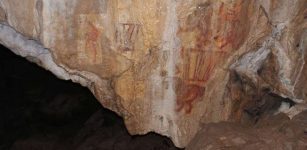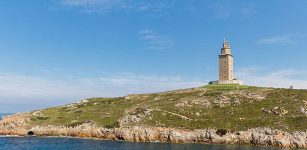Bastet: Protector And Punisher – She Was Among The Most Majestic Egyptian Deities
A. Sutherland - AncientPages.com - In the mythology of the ancient Egyptians, Bastet (or Bast) was a feline goddess and one of the most loved goddesses in Egyptian history. She personified feminine beauty, grace, kindness, fun, and offenders of gods.
She had many temples and shrines to her name. She was especially revered in Bubastis (Tell Basta) in the eastern Delta, but she was also worshiped highly in Memphis, Heliopolis, and Herakliopolis.
 Left: Goddess Bastet; Right: The Goddess Bastet, 305-30 B.C.E. Bronze. Brooklyn Museum
Left: Goddess Bastet; Right: The Goddess Bastet, 305-30 B.C.E. Bronze. Brooklyn Museum
Originally, in earlier beliefs, during the Old Kingdom (c. 2613-2181 BC) when the capital was located in Memphis in Lower Egypt, Bastet was linked with an angry lioness goddess, Sekhmet, destructive and dangerous in nature, and predominantly depicted as a woman with a lion's head. She protected kings when they went to war and was considered a national deity of protection and Pharaoh's guardian goddess.
In the Pyramid Texts, she appeared both in her dangerous form and as a mild-natured mother and nurse of the king, and in the Coffin Texts, her role was to protect the deceased. In later tradition (the end of the second millennium BC), numerous bronze statuettes showed Bastet as a cat-headed, much friendlier deity. Sometimes, she was portrayed holding the rattle-like sistrum instrument.
 “Bastet’s demonic, terrifying aspect is mainly highlighted in the Coffin Texts and the Book of the Dead and in medical spells. The “slaughterers of Bastet” were said to inflict plague and other disasters on humanity” (G. Pinch). One spell advises pretending to be the “son of Bastet” in order to avoid catching the plague. Bastet may be the poisoned cat who is cured by Ra in a myth alluded to in another healing spell.
“Bastet’s demonic, terrifying aspect is mainly highlighted in the Coffin Texts and the Book of the Dead and in medical spells. The “slaughterers of Bastet” were said to inflict plague and other disasters on humanity” (G. Pinch). One spell advises pretending to be the “son of Bastet” in order to avoid catching the plague. Bastet may be the poisoned cat who is cured by Ra in a myth alluded to in another healing spell.
It seems, however, that both aspects of Bastet’s personality that showed her very dualistic nature (a lioness and a cat) existed simultaneously. She could be aggressive, brave, but also gentle, very soft, and caring.
The 1887 archaeological excavations of the ancient city Bubastis revealed Bastet’s main temple, the catacombs of mummified cats, and several pharaonic shrines that confirmed that even the highest royal personalities worshiped Bastet. A Twelfth Dynasty text, for example, compares an Egyptian king to Sekhmet when he punishes wrongdoers and to the goddess Bastet when he protects his loyal subjects.
Bastet’s temple was impressive, and as Herodotus said in his ' Histories’ Book II: "Other temples are greater and more costly, but none more pleasing to the eye than this..."
Bastet was widely celebrated at various festivals, which included music, dancing, sacrifices, and sistrum-playing. These events took place at the famous cult center, Bubastis located in the eastern Delta. Bastet was believed to be the daughter of the sun god and was often identified with the “Eye of Ra.”
As “the Eye of Ra who protects her father Ra,” she was a manifestation of the solar eye. Bastet was regarded as both the daughter and the consort of Atum-Ra (the sun god). Their son, Mahes (Mihos), was a lion deity.
Left: Ruins of Bubastis, which the Persians destroyed in 350 BC. Right: Wadjet-Bastet, with a lioness head, the solar disk, and the cobra that represents Wadjet. source
Occasionally Bastet was also related to the moon and called the “eye of the moon”.
As one of the most popular and the most feminine and graceful goddesses, Bastet was the personification of the feminine. After all, this goddess was revered as the protector of all women, children, and cats. People could appeal to her with any request.
She was considered to be the mother of the lion god Mahes (Miysis). She occasionally was also the mother of Nefertem, who was originally a lotus flower at the world's creation. In art, she was depicted as a beautiful young man having blue water-lily flowers around his head.
The ancient Greeks compared Bastet to their own goddess Artemis. There is a reference to Bastet in Herodotus writing, saying that women were freed from all constraints during annual festivals at Bubastis. They celebrated the festival of the goddess by drinking, dancing, making music, and displaying their genitals. During the annual festivities, the statue of the goddess was taken out of the temple and transported along the banks of the Nile.
According to Herodotus, these were the most elaborate of all the religious festivals of Egypt.
From an ancient story about Prince Setna (composed in the later first millennium BC), we learn about the erotic reputation of the worshipers of Bastet. Setna encountered Taboubu, the beautiful daughter of a priest of Bastet, and instantly fell in love with her. Taboubu agrees to meet Setna in the house of Bastet in Memphis. Before she sleeps with him, Taboubu makes the infatuated Setna sign a deed giving her all his possessions.
Setna is about to embrace Taboubu when he finds himself alone and naked on the public highway. He even lets her kill his own children and feed their bodies to cats and dogs. It has all been an illusion to punish Setna for stealing a magical book from a tomb.
In this story, the tempting Taboubu may be a manifestation of Bastet herself and her traditional role of punisher of humans who have offended the gods.
Written by – A. Sutherland - AncientPages.com Senior Staff Writer
Updated on September 1, 2021
Copyright © AncientPages.com All rights reserved. This material may not be published, broadcast, rewritten or redistributed in whole or part without the express written permission of AncientPages.com
Expand for referencesReferences:
Hart G. A Dictionary of Egyptian Gods and Goddesses
Redford, D. B. The Oxford Encyclopedia of Ancient Egypt
Pinch G. Handbook of Egyptian Mythology
More From Ancient Pages
-
 Limestone Stela Of Liberation Discovered In Kom Ombo Temple In Aswan, Egypt
Archaeology | Oct 17, 2018
Limestone Stela Of Liberation Discovered In Kom Ombo Temple In Aswan, Egypt
Archaeology | Oct 17, 2018 -
 On This Day In History: The Battle Of Fulford Was Fought – On Sep 20, 1066 AD
News | Sep 20, 2015
On This Day In History: The Battle Of Fulford Was Fought – On Sep 20, 1066 AD
News | Sep 20, 2015 -
 Astonishing Upper Paleolithic Camel Cave Painting Discovered In The Ural Mountains
Archaeology | Nov 28, 2017
Astonishing Upper Paleolithic Camel Cave Painting Discovered In The Ural Mountains
Archaeology | Nov 28, 2017 -
 Unique Ancient Figurine Puzzles Scientists – Was She An Unknown Pre-Historic Water Goddess?
Archaeology | Jul 21, 2022
Unique Ancient Figurine Puzzles Scientists – Was She An Unknown Pre-Historic Water Goddess?
Archaeology | Jul 21, 2022 -
 Castor And Pollux: Dioscuri Brothers Immortalized In The Night Sky In Greek Beliefs
Featured Stories | Jan 24, 2024
Castor And Pollux: Dioscuri Brothers Immortalized In The Night Sky In Greek Beliefs
Featured Stories | Jan 24, 2024 -
 How Did Sea Level Rise Impact Human Groups During Mesolithic And Neolithic Periods?
Archaeology | May 20, 2022
How Did Sea Level Rise Impact Human Groups During Mesolithic And Neolithic Periods?
Archaeology | May 20, 2022 -
 DNA Study Of Controversial Ancient North American Mummies, Including The Spirit Cave Mummy Opens An Extraordinary Chapter In Human History
Archaeology | Nov 15, 2018
DNA Study Of Controversial Ancient North American Mummies, Including The Spirit Cave Mummy Opens An Extraordinary Chapter In Human History
Archaeology | Nov 15, 2018 -
 Unsolved Archaeological Mystery Of Ta Prohm Temple, Cambodia
Civilizations | Sep 3, 2018
Unsolved Archaeological Mystery Of Ta Prohm Temple, Cambodia
Civilizations | Sep 3, 2018 -
 Magnificent Meteora And ‘Suspended In The Air’ Greek Monasteries
Featured Stories | May 5, 2021
Magnificent Meteora And ‘Suspended In The Air’ Greek Monasteries
Featured Stories | May 5, 2021 -
 Ancient DNA Sheds New Light On Easter Island Mystery
Archaeology | Oct 13, 2017
Ancient DNA Sheds New Light On Easter Island Mystery
Archaeology | Oct 13, 2017 -
 Is The Hashtag World’s Oldest Symbol And First Communication Attempt?
Ancient Symbols | Apr 27, 2018
Is The Hashtag World’s Oldest Symbol And First Communication Attempt?
Ancient Symbols | Apr 27, 2018 -
 Secrets Of The Cathars – Mysterious Manuscript Of Jesus And His Pre-Flood Language
Featured Stories | Jan 18, 2019
Secrets Of The Cathars – Mysterious Manuscript Of Jesus And His Pre-Flood Language
Featured Stories | Jan 18, 2019 -
 Remarkable Discovery: 2,000-Year-Old Mummy Shroud Found In Museum Collection
Archaeology | Mar 10, 2017
Remarkable Discovery: 2,000-Year-Old Mummy Shroud Found In Museum Collection
Archaeology | Mar 10, 2017 -
 Mysterious Disappearance Of Louis Le Prince – Murder And Cover-Up?
Featured Stories | Jun 27, 2020
Mysterious Disappearance Of Louis Le Prince – Murder And Cover-Up?
Featured Stories | Jun 27, 2020 -
 Ancient DNA’s Analysis Delivers Crucial Clues To Migratory Patterns During The First Millennium AD
DNA | Jan 2, 2025
Ancient DNA’s Analysis Delivers Crucial Clues To Migratory Patterns During The First Millennium AD
DNA | Jan 2, 2025 -
 One Of The Biggest Bronze Age Settlements On Orkney – Discovered
Archaeology | Dec 11, 2015
One Of The Biggest Bronze Age Settlements On Orkney – Discovered
Archaeology | Dec 11, 2015 -
 New West Papua Findings Provide Insights Into Early Human Migration To The Pacific
Featured Stories | Aug 13, 2024
New West Papua Findings Provide Insights Into Early Human Migration To The Pacific
Featured Stories | Aug 13, 2024 -
 On This Day In History: Aztec Calendar Stone Rediscovered – On Dec 17, 1790
News | Dec 17, 2016
On This Day In History: Aztec Calendar Stone Rediscovered – On Dec 17, 1790
News | Dec 17, 2016 -
 Mysterious Bronze Age ‘Golden Tomb’ Unearthed In Armenia
Archaeology | Mar 3, 2023
Mysterious Bronze Age ‘Golden Tomb’ Unearthed In Armenia
Archaeology | Mar 3, 2023 -
 Shakespeare ‘Borrowed’ Phrases From Little-Known Manuscript – Study Reveals
News | Mar 9, 2018
Shakespeare ‘Borrowed’ Phrases From Little-Known Manuscript – Study Reveals
News | Mar 9, 2018

